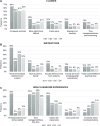Change is never easy: Exploring the transition from undergraduate to dental student in a U.S.-based program
- PMID: 40233065
- PMCID: PMC11999116
- DOI: 10.1371/journal.pone.0321494
Change is never easy: Exploring the transition from undergraduate to dental student in a U.S.-based program
Abstract
The goal of this study was to gain student-centered insights to better understand the challenges of transitioning from undergraduate to dental education. To this end, questionnaires were designed and distributed to incoming dental students, as well as second-, third-, and fourth-year students in the same year for a cross-sectional assessment in 2015/2016. The same questionnaires were also distributed to those same incoming students when they were in their second, third, and fourth years for a longitudinal assessment (2015-2019). There were both open-ended and Likert scale-type questions about expectations (incoming students) and experiences (years 2-4) in dental school compared to undergraduate education. Accordingly, data analysis involved a combination of qualitative and quantitative statistical approaches. Cross-sectional and longitudinal analyses showed that incoming students expected an increased workload in dental school, but also more attention, support, and access to faculty than they received as undergraduates (i.e., they expected a stronger academic support system). All students also reported experiencing more stress and greater difficulty managing their time than expected when compared to their undergraduate experiences. Thus, our study highlights areas of discrepancy between dental students' initial expectations and their lived experience. Importantly, dental schools can take measures to address these discrepancies, foster a better learning environment, and improve students' overall experience to help pave a smooth path for students to become successful and well-prepared oral health care providers.
Copyright: © 2025 Leite et al. This is an open access article distributed under the terms of the Creative Commons Attribution License, which permits unrestricted use, distribution, and reproduction in any medium, provided the original author and source are credited.
Conflict of interest statement
The authors have declared that no competing interests exist.
Figures




Similar articles
-
Beyond labs: unveiling dynamics of dental students' transition from pre-clinical to clinical training in a Saudi dental school.PeerJ. 2024 Sep 10;12:e18019. doi: 10.7717/peerj.18019. eCollection 2024. PeerJ. 2024. PMID: 39282120 Free PMC article.
-
Feasibility and outcomes of paid undergraduate student nurse positions.Nurs Leadersh (Tor Ont). 2006 Sep;19(3):e1-14. doi: 10.12927/cjnl.2006.19032. Nurs Leadersh (Tor Ont). 2006. PMID: 19830923
-
Dental student perceptions of oral and maxillofacial surgery as a specialty.J Oral Maxillofac Surg. 2013 May;71(5):965-73. doi: 10.1016/j.joms.2011.05.014. Epub 2011 Aug 6. J Oral Maxillofac Surg. 2013. PMID: 21820785
-
North American dental students' perspectives about their clinical education.J Dent Educ. 2006 Apr;70(4):361-77. J Dent Educ. 2006. PMID: 16595529 Review.
-
Review and analysis of Chilean dental undergraduate education: curriculum composition and profiles of first year dental students.Hum Resour Health. 2018 Sep 17;16(1):48. doi: 10.1186/s12960-018-0314-8. Hum Resour Health. 2018. PMID: 30223851 Free PMC article. Review.
References
-
- Willison S, Gibson E. Graduate School Learning Curves: McNair Scholars’ Postbaccalaureate Transitions. Equity Excell Educ. 2011;44(2):153–68. doi: 10.1080/10665684.2011.558416 - DOI
MeSH terms
LinkOut - more resources
Full Text Sources

